Today, I’m sharing a review of a knitting pattern book focused on the joy of making. I’m also including the excerpted sweater knitting pattern for Breakfast in Bed as part of the fifth annual Christmas in July Make Along, so read on for details.
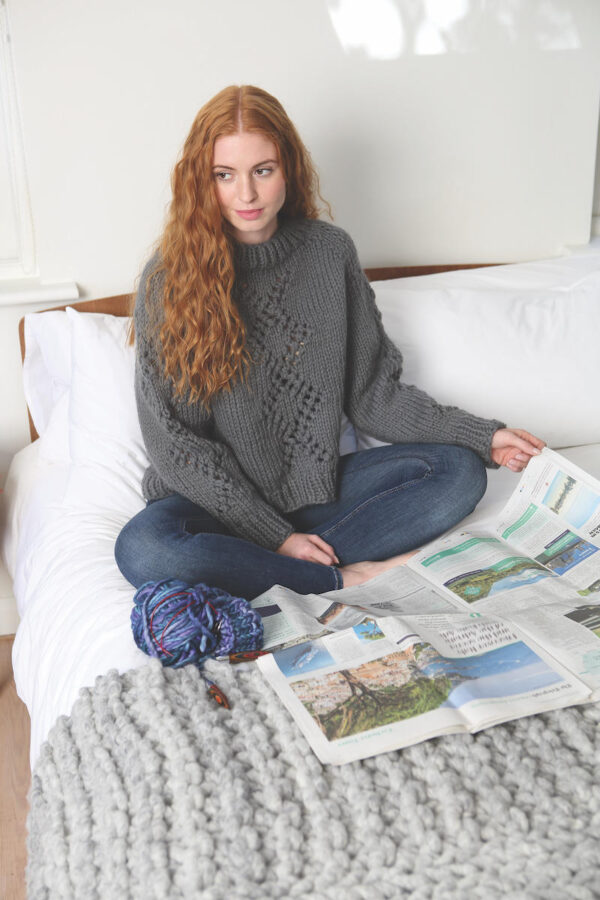
This post contains affiliate links. I may receive compensation (at no added cost to you) if you make a purchase using these links. The Guild of Master Craftsman (GMC) Publications provided me with a free review copy of JOMO Knits: 21 Projects to Celebrate the Joy of Missing Out (available through independent booksellers or on Amazon). Although I accept free products for review, I do not accept additional compensation, nor do I guarantee a positive review. My reviews are based entirely on my honest opinions.
Today’s book review includes the Breakfast in Bed pattern, which is the tenth pattern in the Christmas in July Make Along! To join the Christmas in July Make Along:
- Sign up for Christmas in July Make Along Along updates and the Underground Crafter newsletter to get regular updates, including an update as each pattern is released. When you sign up, you’ll also get access to my subscriber vault which includes exclusive free PDF patterns, a coupon code for your choice of any crochet or knitting pattern or ebook from my Ravelry shop, and coupon codes from other indie designers and crafts businesses.
- Visit this blog post for links to each pattern as it goes live, and to enter the giveaway by Friday, August 4, 2023 at 11:59 p.m. Eastern for your chance to win one of nine prizes from Eucalan, Fox & Pine Stitches, GlassEyesOnline, Hartiful, KennyClayCo, KnitPal, Knitter’s Relief Balm, and seashellcrafter.
- You can join in by crocheting, knitting, sewing, or making the projects as you have time.
- Share your progress and post pictures of your finished projects. Tag your projects and posts #CIJMakeAlong2023 on all social media.
- If you’d like to chat with other crafters, join the Underground Crafters Facebook group.
- If you need more handmade holiday inspiration, check out the weekly roundups with even more free patterns for gift ideas.
- By the end of the Make Along, you’ll have up to 31 awesome projects. Get ready for the handmade holiday season while having fun with us!
- Use this button below on your Ravelry project pages or elsewhere on social media. Right click (on desktop) or tap and hold (on mobile) to save.

Book Review: JOMO Knits
JOMO Knits: 21 Projects to Celebrate the Joy of Missing Out (available through independent booksellers or on Amazon) by Christine Boggis is a collection of knitting patterns with an emphasis on the joy of creating. Christine opens the book with an introduction – What is JOMO? – that describes JOMO as the joy of missing out, and as the opposite of FOMO (the fear of missing out) which emphasizes competition and “constant consumption.” Christine explains that

JOMO is about something slowly, so that you or someone you love can treasure it forever, or making for the sheer joy of making. It’s about making something that suits your body shape, whatever that may be. It’s about fudging together something that might have a few mistakes but is perfect in its own way, or about knitting up and ripping back the same thing over and over again until it’s exactly how you want it. It’s about sitting at home content that, if you are missing out on something, it’s not as good as what you’re doing right now.
Christine Boggis, JOMO Knits
In this section, Christine also explains that the patterns are knit in chunky (bulky) yarns and that all are achievable for beginners, though also interesting for more advanced knitters.
The book is then divided into three sections of patterns: Nest, Explore, and Share. The patterns in the Nest section are “designed for cocooning and comfort;” the patterns in the Explore section are about “tak[ing] time to explore yourself;” and the patterns in the Share section are designed as gifts. (The sweater knitting pattern for Breakfast in Bed, excerpted below, opens the Nest section.) Each pattern includes:
- An introduction, describing the project;
- Sizes, including measurements in both inches and centimeters;
- You will need, including yarn listed by brand but also fiber type and yardage/meterage, recommended knitting needles sizes, and other notions;
- Tension (gauge), including the pattern repeat required to check tension;
- Abbreviations, including special abbreviations, if any;
- Pattern note, which provides construction details and referrals to special techniques used; and
- The written pattern using abbreviations. Some patterns also contain charts and/or schematics.
Each pattern includes at least one full page photo and multiple smaller photographs. The book includes patterns for:
- 4 hats;
- 4 sweaters;
- 2 blankets;
- 2 pairs of mitts/mittens;
- And 1 of each of the following patterns: bag, booties, cardigan, coat, cowl, pillow, scarf, shawl, and a pair of socks.
Each section also includes side bar sections such as An Introduction to Modern Literature, which shares favorite fiction and non-fiction knitting books; 5 Ways to Find More Time for Knitting; and A Knitting Night In in the Nest section; 5 Inspiring Knitters; Craft Yourself Well, which provides tips for mindful knitting; and Places You Can Knit in the Explore section; and Knit For a Cause; Find Your Tribe, about connecting with other knitters; and 5 Life Lessons I’ve Learned from Knitting in the Share section. Additionally, there are tips and tutorials interwoven with the patterns, such as how to crochet a zip (zipper), how to wet splice yarn, how to make your own beaded stitch markers, and how to work out decreases.
After the pattern sections, there is a Tools and Techniques section that includes:
- Tools of the Trade, explaining needles and notions;
- A Yarn to Spin, describing different fiber types;
- Is This a Wind Up?, explaining how to wind yarn;
- Before You Begin exploring taking measurements for sizing, and creating and measuring a tension/gauge swatch;
- Casting On Techniques, with written and photo instructions for holding yarn using both the English and Continental methods; long tail, knitted-on, garter stitch tab, and Judy’s magic cast on methods;
- the Knit and Purl Stitches with written and photo tutorials for knit and purl stitches and working through the back loop;
- Shaping Your Work, with written and photo tutorials for increases and decreases including knit front and back, yarn overs, make one left and make one right, knit two together, slip slip knit, and slip one knit one pass slipped stitch over;
- Knitting In the Round, which provides written and photo instructions for the magic loop method of small circumference knitting in the round on circular needles and the jogless join;
- Cables, with written and photo instructions for two types of cable patterns;
- Fairisle or Stranded Knitting, with written and photo instructions for holding yarn and working stranded colorwork;
- Brioche Knitting, including written and photo instructions for one-color brioche knitting worked flat, two-color brioche knitting worked flat, one-color brioche in the round, and two-color brioche in the round;
- Useful Techniques, which includes written and photo instructions for the Kitchener stitch join, picking up stitches, and shadow-wrap short rows;
- Casting Off, including written and photo tutorials for the standard cast off and three needle cast off;
- Crochet Techniques, with written and photo instructions for the slip stitch, chain stitch, UK double crochet (US single crochet), and UK half treble crochet (US half double crochet); and
- Finishing Techniques, with written and photo instructions for weaving in ends, blocking, mattress stitch join, duplicate stitch, and making pom poms.
The book closes with a list of UK pattern abbreviations, conversions between UK and US measurements for needles and hooks and UK and US knit and crochet pattern abbreviations, a list of suppliers, acknowledgements, and an index.
While I described JOMO Knits as a pattern collection, as you can see from the list above the Tools and Techniques section is more detailed than what you would find in most pattern books. Additionally, because the instructions include progress photos rather than solely written instructions or written instructions with illustrations (which some folks find challenging to interpret), this book has a lot of additional elements that could make it ideal for the beginning knitter would would like to transition their skills to a more advanced level. Additionally, there are lovely photos throughout which make the book great “eye candy.” Although it is a paperback book, it has flaps on both the front and back cover to make it easier to hold your place while knitting. I recommend this book for newbies to intermediate knitters who are eager to join the “slow fashion” movements, who are looking for ways to build a knitting community, who enjoy accessories that are classic and timeless looking, or who enjoy knitting with bulky yarns. Since this post is part of the Christmas in July Make Along, I should also mention the book would make a great gift for another knitter, and there are also many gift ideas inside if you’d like to buy it for yourself. You can find JOMO Knits: 21 Projects to Celebrate the Joy of Missing Out sing Out through independent booksellers or on Amazon. Read on for the free sweater knitting pattern excerpt for Breakfast in Bed!
Breakfast in Bed
Sweater Knitting Pattern by Christine Boggis
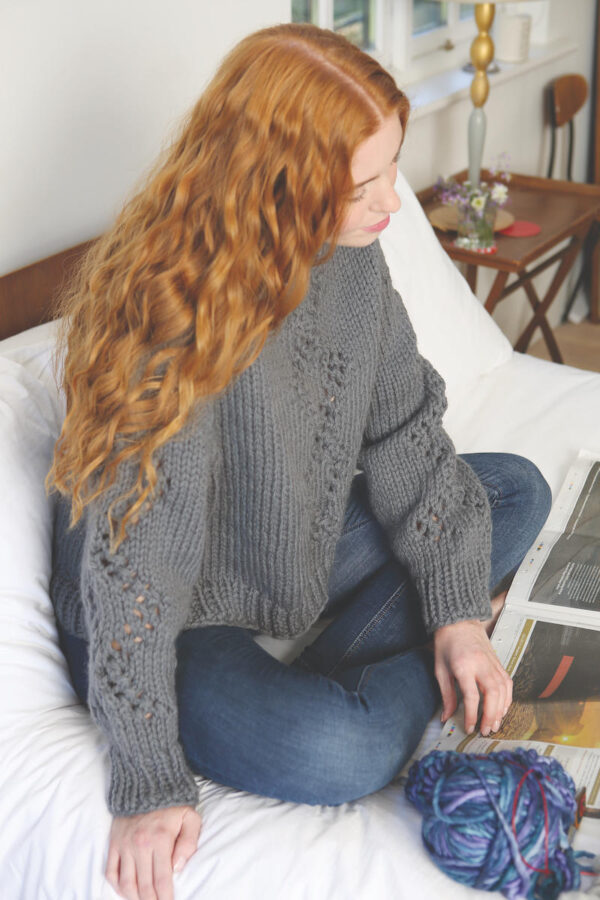
Published in JOMO Knits: 21 Projects to Celebrate the Joy of Missing Out (available through independent booksellers or on Amazon) by Christine Boggis. Text and designs © Christine Boggis, 2019. Copyright in the Work © GMC Publications Ltd, 2019. Shared with permission from GMC Publications Ltd.
This top-down, in-the-round jumper with pretty lace panels and trendy bishop sleeves is perfect for those days when you just want to stay home and snuggle up. The Cable Twist Lace pattern comes from Wendy Bernard’s brilliant book, The Knitting All Around Stitch Dictionary (available from independent booksellers or on Amazon).
Sizes
- To fit bust: 32–34[36–38:40–42:44–46]in (81–86[91–97:102–107:112–117]cm)
- Actual bust: 46[50.5:55:59]in (117[128:140:150]cm)
- Front length: 21.25in (54cm)
- Back length: 24.75in (63cm)
- Sleeve length: 16in (41cm)
- Figures in square brackets refer to larger sizes. Where only one set of figures is given, this applies to all sizes.
You will need
- Erika Knight Maxi Wool 100% pure British wool (approx. 87yd/80m per 100g)
- 7[7:8:9] x 100g hanks in Storm
- 10mm (UK000:US15) circular needle 40in (100cm) long
- Set of 10mm (UK000:US15) double-pointed needles (optional)
- 11 stitch markers
- Stitch holders or scrap yarn
- Note: Yarn amounts are based on average requirements and are approximate.
Tension
- 9.5 sts and 13 rows to 4in (10cm) over st st.
- One Cable Twist Lace pattern repeat (15 sts and 18 rounds) measures
6¼ x 5½in (16 x 14cm). - Use larger or smaller needles if necessary to obtain the correct tension.
Abbreviations/Notes from Underground Crafter
- This pattern uses standard knitting abbreviations. You can find a helpful list from the Craft Yarn Council here.
- Please note that the UK term “cast off” is equivalent to “bind off” in the US.
- Note that w&t refer to the wrap & turn method of short row shaping (see tutorial at end of the pattern for shadow wrap short rows).
- Very Pink Knits has a helpful video tutorial for the ssk (slip slip knit) decrease here.
- Fiber Flux has a helpful video tutorial for the yo (yarn over) increase here.
- Fiber Flux has a helpful video tutorial for the k2tog (knit 2 together) decrease here.
- Studio Knit has a helpful video tutorial for the kfb (knit front and back) increase here.
- Very Pink Knits has a helpful video tutorial for the knitted-on method cast on here.
Pattern note
- Stitch markers are used to denote the start and end of each round; the division between left back and left sleeve (m1); left sleeve and front (m2); front and right sleeve (m3); and right sleeve and right back (m4). Other markers may be used to denote the start and end of each pattern panel. These will not be numbered. Make sure you know which marker is which. Where markers are not mentioned, simply slip them.
- I used shadow wrap short rows (see tutorial at end of the pattern) for the short row shaping.
Cable Twist Lace pattern
- Worked over 15 sts and 18 rounds.
- Round 1: K1, (ssk, yo) twice, k5, (yo, k2tog) twice, k1.
- Round 2 and all alt rounds: Knit.
- Round 3: K2, (ssk, yo) twice, k3, (yo, k2tog) twice, k2.
- Round 5: K3, (ssk, yo) twice, k1, (yo, k2tog) twice, k3.
- Round 7: K4, (ssk, yo) twice, k1, yo, k2tog, k4.
- Round 9: K5, (ssk, yo) twice, k6.
- Round 11: K5, yo, ssk, yo, sk2po, yo, k5.
- Round 13: K4, yo, k2tog, yo, ssk, yo, sk2po, yo, k4.
- Round 15: K3, (yo, k2tog) twice, k1, (ssk, yo) twice, k3.
- Round 17: K2, (yo, k2tog) twice, k3, (ssk, yo) twice, k2.
- Rounds 1–18 form patt and are repeated.

Jumper
- With the circular needle, cast on 60 sts using the long tail method (see tutorial below pattern). Using the magic loop method (see tutorial below pattern), join to work in the round, taking care not to twist stitches, pm to mark beg of round at mid-back.
- Round 1: (K1, p1) around.
- Rep round 1 five more times.
- Next round (inc): Kfb, k to end (61 sts).

Shape back neck
- Set-up round: K13, pm1, k5, pm2, k25, pm3, k5, pm4, k13.
- Short row 1: K to m2, sm, k2, w&t.
- Short row 2: P back across start-of-round marker to m3, sm, p2, w&t.
- Short row 3: K to m2, sm, k1, w&t.
- Short row 4: P to m3, sm, p1, w&t.
- Short row 5: K to end of round.
Set raglan increases and lace panel
- Note: Read all this section before starting work: the whole increase pattern is detailed before the lace panel instructions are given, but both are worked at the same time.
- Round 1 (inc): Knitting wraps tog with wrapped sts as you come to them, work as foll: *K to 1 st before marker, m1L, k1, sm, k1, m1R; rep from * four times, k to end (69 sts: 14 for Left back, 7 sts each Sleeve, 27 for Front, 14 for Right back).
- Round 2: Knit.
Size 1 only
- Round 3: Knit.
- Rep last 3 rounds 9 times (141 sts: 23 sts for each side of Back, 25 for each Sleeve and 45 for Front).
Sizes 2, 3 and 4 only
- Rep last 2 rounds 3[9:13] times (93[141:173] sts).
- Next round (inc): Rep inc round (101[149:181] sts).
Sizes 2 and 3 only
- Knit 2 rounds.
- Rep last 3 rounds 6[2] more times (149[165] sts).
All sizes
- Rep inc round 0[1:1:1] more time. 141[157:173:189] sts: 23[25:27:29] for each side of Back, 25[29:33:37] for each Sleeve and 45[49:53:57] for Front. After this round, divide body and sleeves.

AT THE SAME TIME set Cable Twist Lace patt as folls:
Front
- Round 4: K to m2, sm, k7, pm, work row 1 of Cable Twist Lace patt, pm, k to end.
- This round sets position of Cable Twist Lace patt on front. Cont in patt throughout.

Sleeves
- Round 16: K to m1, sm, k2, pm, work row 1 of Cable Twist Lace patt, pm, patt to m3, k2, pm, work row 1 of Cable Twist Lace patt, pm, k to end.
- This round sets position of Cable Twist Lace patt on sleeves. Cont in patt throughout.
Divide body and sleeves
- Next round: K to m1, remove m, slip sleeve sts to scrap yarn, using knitted-on method (see Notes from Underground Crafter above) cast on 10[10:12:12] sts, pm after 5th[5th:6th:6th] cast-on st, remove m2, patt to m3, remove marker, slip sleeve sts to scrap yarn, using knitted-on method cast on 10[10:12:12] sts, pm after 5th[5th:6th:6th] cast-on st, remove m4, k to end. 109[119:131:139] sts: 27[30:33:35] for each side of Back and 55[59:65:69] for Front.
- Tip: Make a note of which row of the lace pattern you are on for the sleeves so that it is easier to pick up when you come back to them.
Body
- Cont in patt as set, slipping markers, until a total of 3 full reps of Cable Twist Lace patt have been worked.
Shape back hem
- Short row 1: K28, w&t.
- Short row 2: P to end of round, p28, w&t.
- Short row 3: K to last st before wrapped st, w&t.
- Short row 4: P to last st before wrapped st, w&t.
- Rep rows 3 and 4 once more, then k to end of round.
- Next round: K2tog, knit to end (108[118:130:138] sts).
- Next round: (K1, p1) around.

To finish
- Weave in ends neatly. Pin to measurements, cover with damp cloths and leave to dry.
Long-tail cast on
The long-tail method is a stretchy cast on perfect for socks, hats, mittens and anything else that needs a bit of give.
- 1 Start with a long tail, leaving about 1in (2.5cm) for each stitch to be cast on. Make a slip knot and slip it onto a knitting needle.

- 2 With your left hand, create a slingshot shape: wrap the working yarn clockwise over your index finger, wrap the tail anticlockwise over your thumb and grasp the yarn ends in the remaining three fingers.

- 3 Use the needle tip to pick up the strand of yarn around the outside of your thumb, forming a loop.
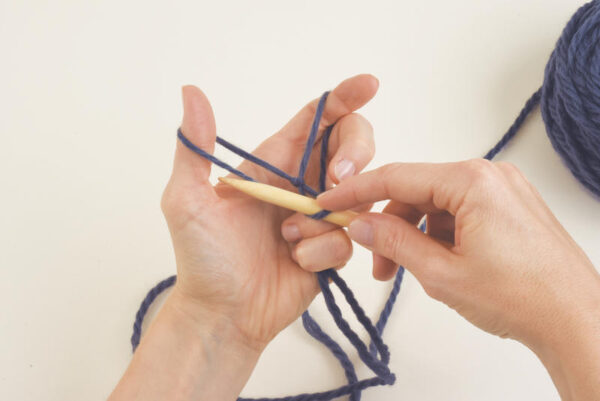
- 4 Then pick up the strand of yarn on the inside of your index finger and pull it through the loop.

- 5 Let the yarn go and pull to tighten (not too tight).You now have two stitches cast on. Repeat steps 2–5 until you have cast on the required number of stitches.
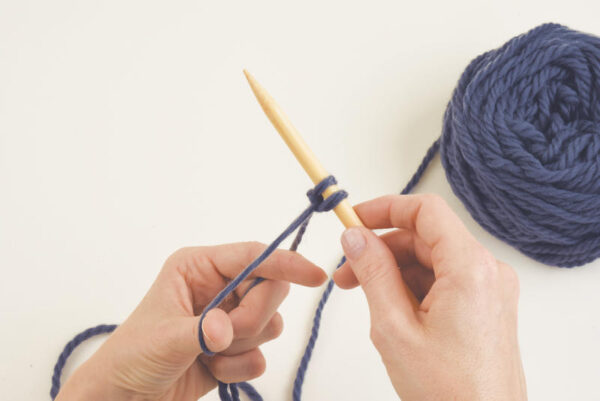
The magic loop method
There are several ways to knit in the round: you can use a number of double-pointed needles or a circular needle exactly the right size for your knit. The magic loop method is handy because you can use the same circular needle for any size of knitting. It is simpler than it looks – once you’ve got going, you’re sure to love it.
- 1 Cast on the number of stitches you want and slide them onto the connecting cable of your circular needle.
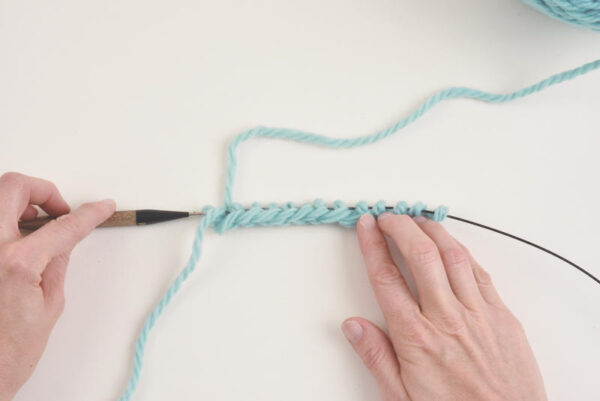
- 2 Find the middle of the stitches and pull the cable out through this point – but not so far that any stitches drop off the ends of the needle tips.

- 3 Leave the half of the stitches connected to the working yarn on the cable – these will be known as the back stitches. Slide the other half of the stitches onto the left-hand needle tip. These are the front stitches.
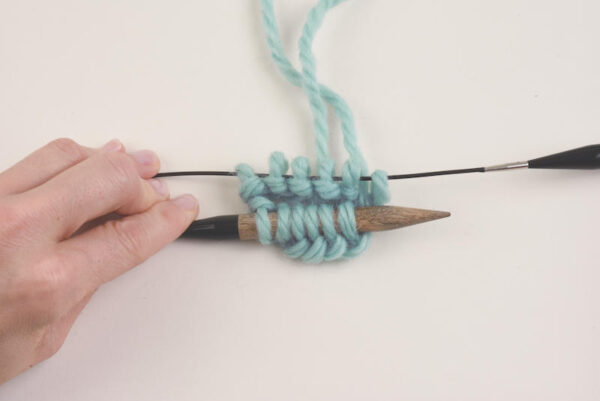
- 4 Bring the right-hand needle tip around and knit the first stitch on the left-hand needle tip. Pull the working yarn tightly afterwards; you will find your stitches have joined in a loop. It is a good idea to place a marker at this point so that you know where your round begins and ends.

- 5 Carry on knitting until you have worked all the front stitches. Taking care not to turn the stitches you have worked upside down or inside out, turn the work around so that the stitches you have just knitted are now sitting at the back on the left-hand needle tip and the cast-on stitches are at the front on the cable.
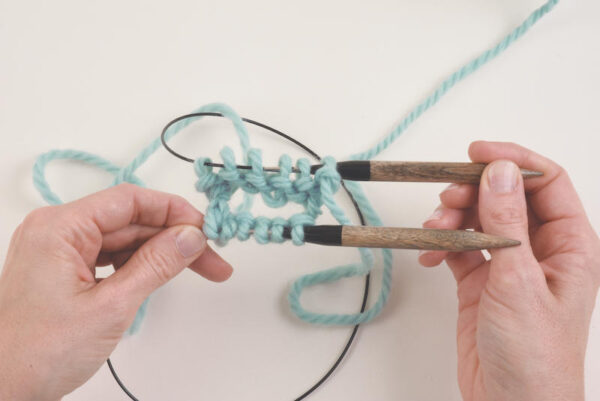
- 6 Pull the cable until the cast-on stitches now at the front of the work are sitting on the needle tip in front of the other needle tip. This is now your left-hand needle. Take care not to drop any stitches at this point. Pull the needle tip at the back out of the back stitches so that they now sit on the cable. This is now your right-hand needle tip. Bring this needle tip around and work the first stitch on the left-hand needle. Carry on knitting until you have worked all the stitches on the needle tip. You have now knitted one round. Repeat for as many rounds as you like, creating a neat tube of knitting.

Shadow-wrap short rows
There are a number of ways to work the ‘wrap and turn’ used to avoid holes when shaping fabric using short rows. My favourite is the shadow-wrap method, invented by Socktopus author Alice Yu; this is very neat and less fiddly than some other methods.
- 1 Work up to the point where you are asked to wrap and turn in your pattern, then knit the stitch to be wrapped. Underneath this stitch you will notice the stitch that came before it – Alice calls this the ‘mama’ stitch, while the stitch on the needle is the ‘daughter’ stitch.

- 2 Lift the mama stitch onto the left-hand needle, taking care not to twist it, then knit it and drop it off the left-hand needle.

- 3 You now have two stitches on the right-hand needle, both coming out of the same mama stitch – the daughter stitch and the ‘shadow’ stitch. Next time you come to these two stitches, you will work them together as if they were one stitch.

- 4 To work a shadow wrap purlwise, work to the stitch to be wrapped, then slip it purlwise onto the right-hand needle.

- 5 Lift the mama stitch of the slipped stitch onto the left-hand needle, being careful not to twist it, then purl it and drop the mama stitch off the needle.
Once again, you have a daughter stitch and a shadow stitch coming out of the same mama stitch. When you come to these stitches again, work them as if they were one stitch.


